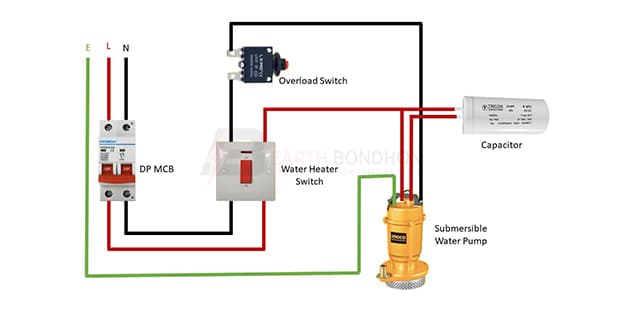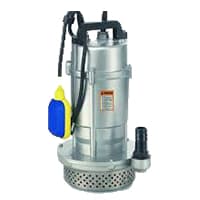Submersible Motor Control Box Connection:
This diagram shows how to make Submersible Motor Control Box Connection. In this circuit, we use a DP MCB ( Double Pole Miniature Circuit Breaker ), an overload switch, a water heater switch, a capacitor, and a single-phase submersible water pump. This circuit is very simple and easy to make. If you want to know more about this circuit please stay check our youtube video for clear details.
Advertisements
Components needed For this Project:
You can get the components from any of the sites below:
- DP MCB 16A [See Buy Click Amazon]
- DP 20A Switch [See Buy Click Amazon]
- Overload switch [See Buy Click Amazon]
- 50 MFD Capacitor (220V ac Line) [See Buy Click Amazon]
- single phase Submersible water pump (1 HP) [See Buy Click Amazon]
*Please note: These are affiliate links. I may make a commission if you buy the components through these links. I would appreciate your support in this way!
Advertisements
Components used to make the Submersible Motor Control Box Connection:
DP MCB In 2 Pole MCB, switching & protection is affected in phases and the neutral. A Double Pole or DP Switch is a Switch that Controls 2 Circuits at the same time. In terms of Residential Switching, this Normally means it Switches the live and Neutral at the same time. In Layperson Terms, Double Pole switches or DP Switches are Exclusively Designed to Control 2 Different Electrical Circuits at the same time, which allows the Appliances to Isolate safely and reliably. Fan or light Combinations and Medical Equipment are some of the many applications for DP Electrical Switches and Electrical components.
02. DP Switch:
20 amp Double Pole Switches are generally used with Electrical appliances that need to be hard-wired as opposed to using a Plug and power Socket. Double pole switches make it possible to isolate appliances safely from the power supply source. double pole switches or DP switches are exclusively designed to control 2 different electrical circuits at the same time.
An overload relay is a safety device that protects your circuit diagram against damage caused by high-power loads. The relay opens if the load exceeds a certain amount. protecting the circuit from destruction. The simplest version of an overload relay is a single-pole, single-throw (SPST) switch. An overload relay is also referred to as a relay switch. switch is a device that opens the circuit in the event of an electrical, thermal, or power overload system. When mounted with a contactor they create a motor starter connection.
04. Capacitor:
Motor Starting Capacitors are used during the Motor Startup Phase and are Disconnected From the Circuit once the Rotor Reaches a Predetermined Speed, Which is Usually about 75% of the Maximum Speed for that Motor type. These Capacitor Usually Have Capacitance Values Of Over 70 UF. The Starting capacitor creates a Current-to-Voltage lag in the Separate start Windings of the Motor. Starting Capacitor are Wired into The Auxiliary Winding Circuit of the Motor and are Disconnected from the main winding circuit by the Centrifugal Switch once the Motor has Reached a Predetermined Speed.
A Submersible Pump Is an Air-Tight Sealed Motor Close-Coupled to The pump is body. The Main Advantage of This Type of Pump is That it Prevents Pump Cavitation, a Problem Associated With a High Elevation Difference Between the submersible Pump and the Fluid Surface. Submersible Pumps As The Name Suggests Are made To Be fully Submerged in Water. It is a Centrifugal Water Pump, Meaning It Has a Motor That Powers An impeller Designed to Rotate And Push Water Outwards. The Motor is located Within a Waterproof Seal and is Closely Coupled to The body of The Pump That it Powers.
Thank You for visiting the website. Keep visiting for more Updates.
Frequently asked questions
As submersible pumps are fully submerged, the pressure of the water surrounding them prevents air from being trapped. As a result, all submersible motors are self-priming. The water surrounding the pump helps to keep it cool or prevents overheating.
Submersible motor starters are your safeguard, and a submersible starting motor panel keeps your water supply from short-circuiting. They serve both functions by avoiding overloading or short-circuiting. It is simple to do with a simple on-and-off switch operation.
A submersible pump capacitor is an electrical device that provides an extra power supply to start and run a submersible pump. It stores electrical energy or releases it when needed to help the pump operate efficiently.
These tests are outlined in ANSI/HI 11.6 Rotodynamic Submersible Pumps for Mechanical or Electrical Acceptance Tests. Two common types of mechanical integrity tests exist. They are the housing pressure test or the housing vacuum test. These tests ensure there are no holes, cracks, or openings in the pump housing.
Submersible pumps are used to pump out water to a minimum depth of 15 cm and from open water to supply an incident ground with water. Submersible pumps could be lowered into a subway or down a cliff into open water or still operate.
Read more Single Phase Wiring
What is a kilowatt-hour (kWh) | kwh formula | What does kwh mean
Introduction to Electrical Units and CircuitskW and kWh on your electricity bill As your home uses electricity during...
What is the Difference Between kVA | What does KVA mean | kVA formula
Difference Between KVA ExplainedWhat does KVA Mean? There are technical terms aplenty when it comes to generators, and...
Power Factor | Power Unit | Energy | Electricity Unit
Power factor definition | Calculating Power FactorPower Factor Values In a purely resistive circuit, the power factor...






0 Comments